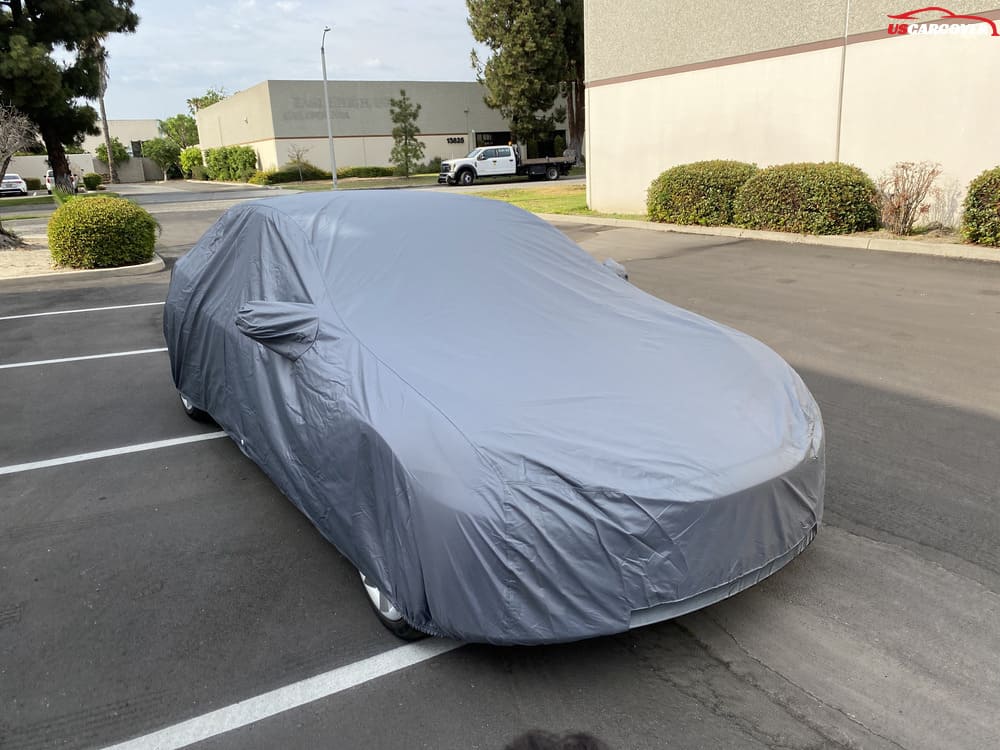
Discover how to choose the perfect car cover fit to protect your vehicle from weather, dust, and damage. Learn why custom-fit car covers offer superior protection and preserve your car's value. Shop at USCarCover.com today for high-quality, affordable car covers!
Choosing the right car cover size is one of the most critical decisions for protecting your vehicle. A car cover that fits perfectly ensures maximum protection against weather elements, dust, debris, and even potential scratches. However, many vehicle owners overlook the importance of proper fit, assuming that any cover will do the job. This common misconception often leads to reduced protection and premature wear on both the cover and the car.
A well-fitting car cover not only guards your vehicle but also offers a snug, tailored appearance, which can significantly extend the lifespan of both the cover and the car's exterior. On the other hand, an ill-fitting cover can flap in the wind, trap moisture, or fail to provide full coverage, leaving parts of the vehicle exposed. Over time, this can result in paint damage, rust, or even more severe wear-and-tear issues.
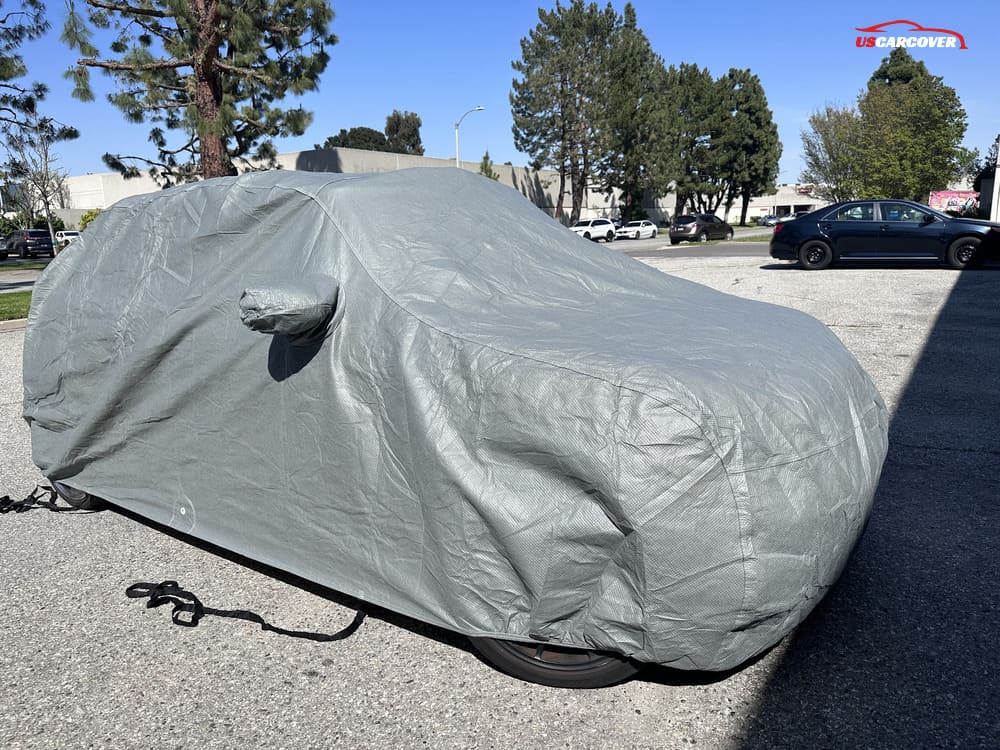
When it comes to car cover fit, it's not just about finding something that covers your car — it's about selecting the ideal size that matches the unique contours of your vehicle. A properly sized cover ensures that every curve, edge, and detail is adequately protected, giving you peace of mind whether you're parking indoors or outdoors.
In this guide, we’ll explore the importance of choosing the right car cover size, why fit matters, and how to measure your car for the best possible coverage. Whether you’re looking for protection from harsh weather, dust, or just general wear, selecting the perfect fit is crucial to ensuring your vehicle remains in pristine condition for years to come.
Related Articles: How to Prevent Your Car Cover from Being Stolen: Top Tips and Security Solutions
Why Fit and Size Matter for Car Covers
The fit and size of a car cover are critical when it comes to providing your vehicle with full protection. A car cover that’s too large can flap in the wind, allowing dirt and moisture to seep underneath, which can cause long-term damage to your paint job. On the other hand, a cover that’s too tight may be difficult to put on and remove, and it could also cause scratches or scuff marks on your car's surface if there’s too much tension.
A properly fitted car cover is designed to snugly hug the shape of your vehicle, ensuring that no part is left exposed. This is particularly important for outdoor car covers, which need to withstand everything from heavy rains to strong winds. A loose cover can easily be displaced or blown off, leaving your car vulnerable to the elements. Moreover, poor-fitting covers tend to wear out faster because of the constant movement and stress, meaning you’ll need to replace them more frequently.
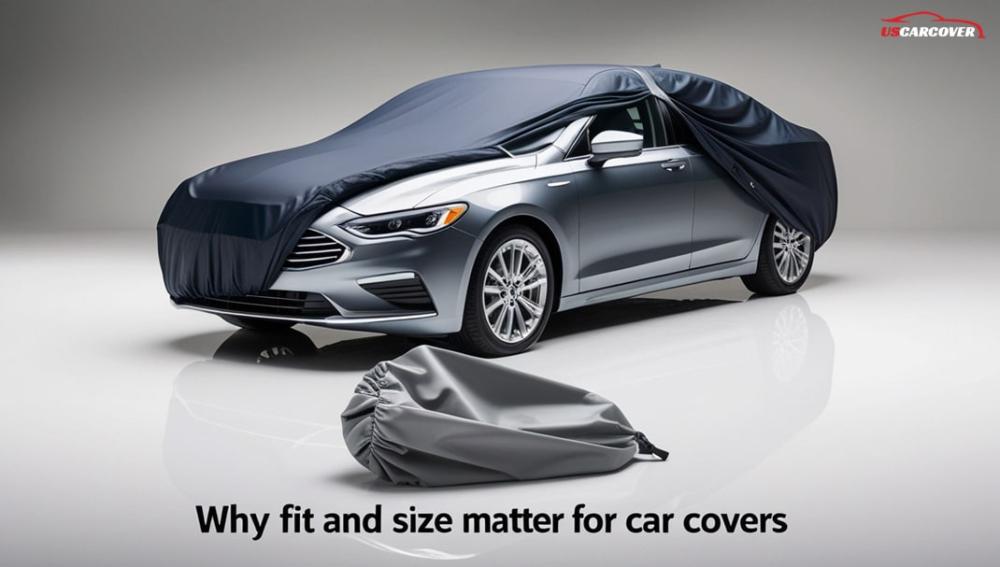
When considering the right car cover size, think about how it will interact with your vehicle under different conditions. For example, all-weather car covers need to fit securely to protect against rain, snow, and UV rays, while indoor car covers are more concerned with dust and scratches. In either case, a perfect car cover fit helps maintain the cover’s integrity, ensuring long-term use and consistent protection for your vehicle.
In addition, an ill-fitting car cover may allow moisture to get trapped beneath the fabric, leading to potential problems like mold, mildew, and rust formation over time. These are often overlooked issues that can cause serious damage, especially for cars stored outdoors in humid or rainy climates.
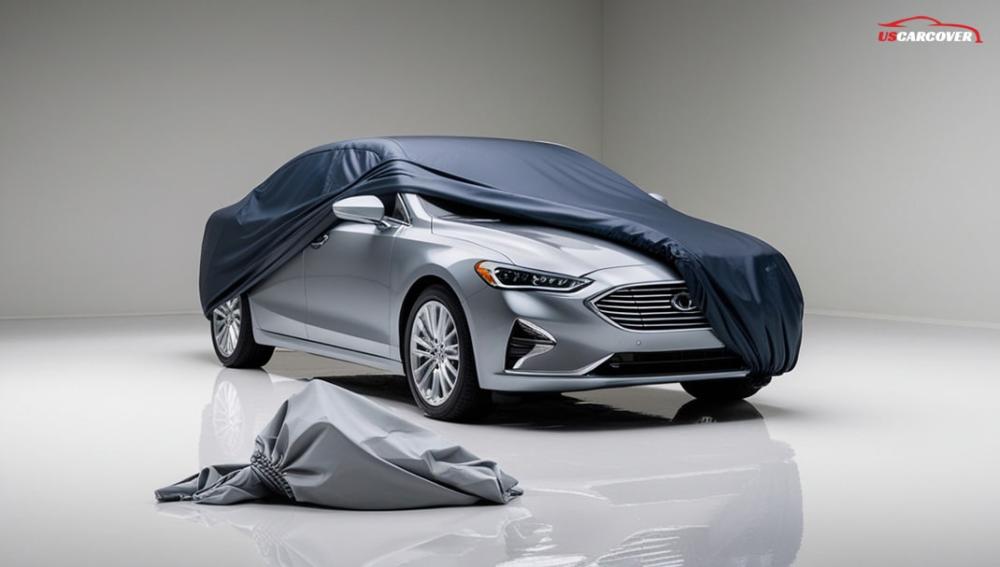
To sum it up, selecting the right size and fit is not just about aesthetics; it’s about making sure your vehicle stays fully protected from external hazards. Whether you’re using a car cover for short-term or long-term storage, ensuring it fits properly is essential for maximum coverage and the best results.
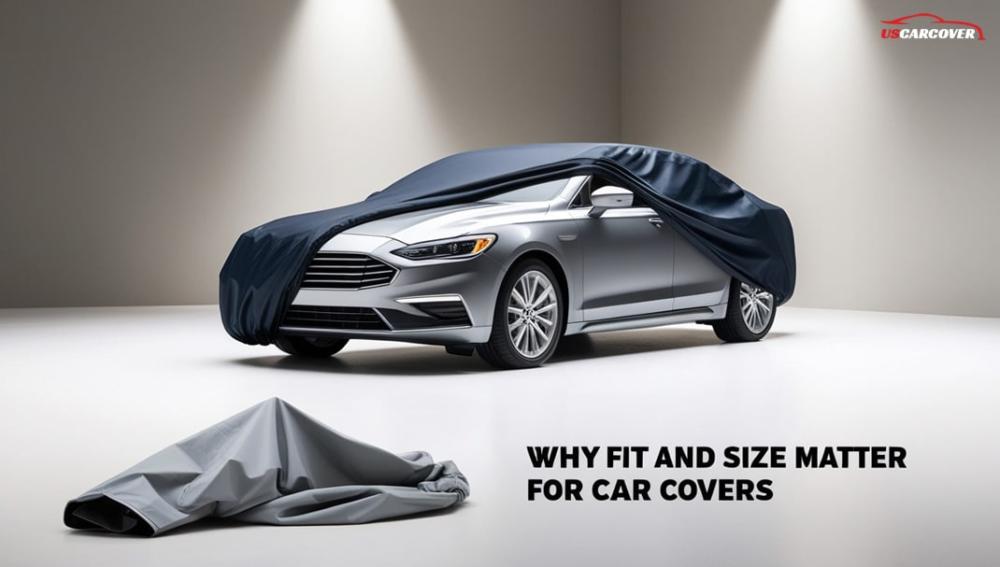
Related Articles: Top 4 Materials For Indoor Car Covers
Common Mistakes When Choosing Car Cover Size
Selecting the right car cover size may seem straightforward, but many vehicle owners make common mistakes that can reduce the effectiveness of their cover. Choosing the wrong size or type of car cover can leave your vehicle vulnerable to damage, defeating the purpose of investing in protection. Let’s explore some of the most frequent errors and how to avoid them.
One of the most common mistakes is opting for a universal car cover size without considering the specific dimensions of the vehicle. While universal covers can work for some, they often lack the precise fit that’s needed to fully protect the car. These covers are designed to fit a range of sizes, but that often means they don’t fit any vehicle perfectly. A loose or baggy cover may billow in the wind, allowing debris and water to get under it, while one that’s too small can stretch and tear over time.
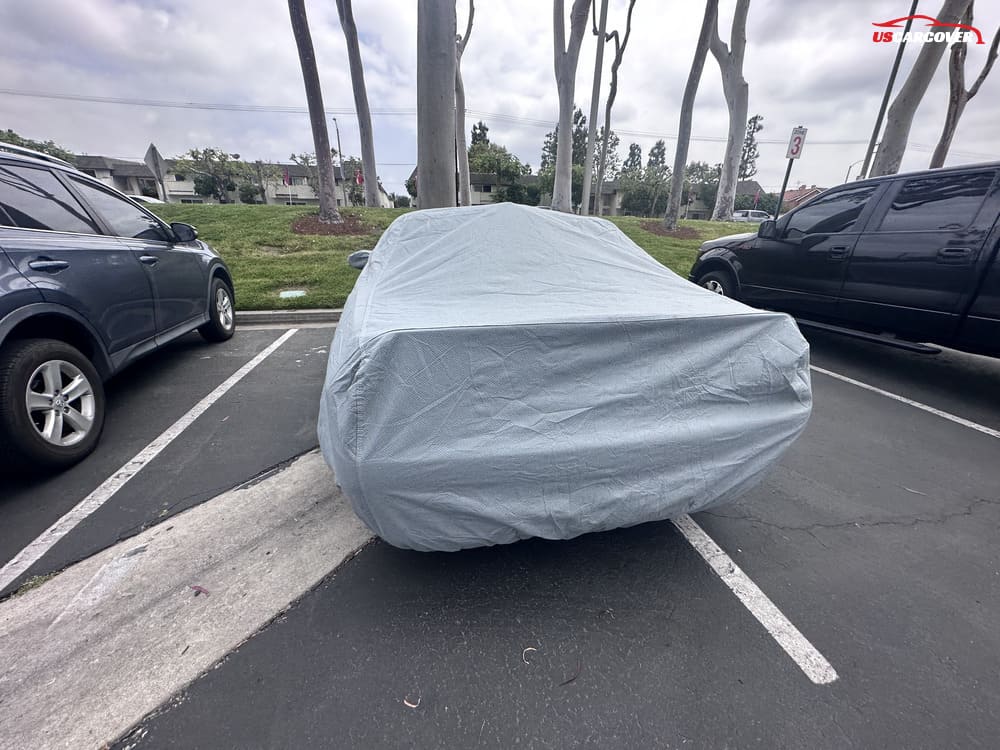
Another frequent error is not accounting for additional features on your car, such as roof racks, spoilers, or extended mirrors. These additions alter the overall dimensions of your vehicle, and if you don’t factor them in, even a custom car cover may not provide adequate coverage. The result? Parts of your car might remain exposed, leaving them susceptible to scratches, sun damage, or moisture buildup.
Many car owners also neglect to check the manufacturer’s sizing chart before purchasing. It’s essential to follow the guide provided by the cover manufacturer to ensure the best car cover fit. Relying on general assumptions or eyeballing the size often leads to frustration and returns. Proper measurement ensures that the cover fits snugly around your car, providing complete protection from top to bottom.
One mistake that’s often overlooked is failing to consider the purpose of the cover. For instance, if you need an outdoor car cover, the fit must be more secure to handle wind and weather, whereas an indoor cover may not require the same level of tightness. Many users buy a single cover without considering its intended use, leading to poor performance in the long run.
In conclusion, avoiding these common car cover sizing mistakes can save you time, money, and the hassle of replacing covers too soon. Ensuring you choose the right size based on your car’s unique dimensions and the cover’s intended use will result in better protection and a longer-lasting product.
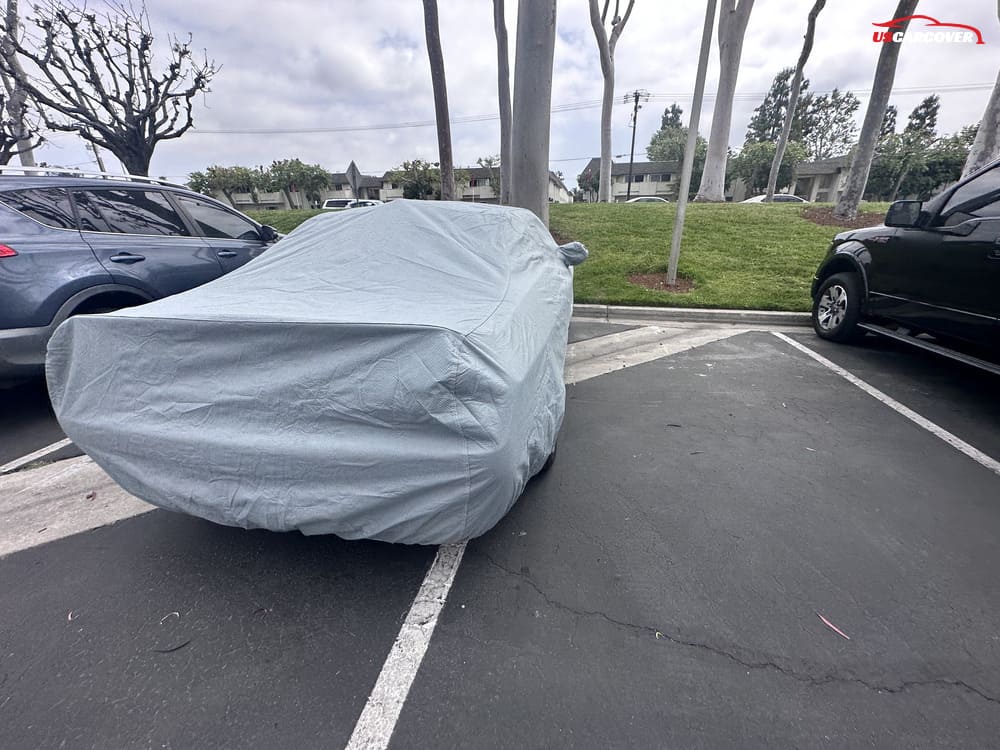
Related Articles: 5 Affordable Car Covers Under $100
How to Measure Your Vehicle for the Perfect Car Cover Fit
Getting the perfect car cover fit starts with accurately measuring your vehicle. Without the correct measurements, you risk purchasing a cover that’s either too loose or too tight, both of which can reduce its effectiveness. Follow these simple steps to ensure you get the right size and optimal protection for your car.
Step 1: Measure the Length of Your Vehicle
Using a tape measure, start at the front bumper and extend it all the way to the back bumper. This will give you the total length of the vehicle. Be sure to include any extra features like rear-mounted spare tires or bike racks, as these add to the overall length and need to be covered for full protection. The length measurement is essential for determining the baseline size for the car cover.
Step 2: Measure the Width
Next, measure the widest part of your vehicle, typically from side mirror to side mirror. For some cars, folding mirrors inward is an option when putting on a cover, but for larger vehicles, including SUVs or trucks, the width of the vehicle should account for these features. Ensuring the cover can stretch across the widest points ensures it will fit securely without being overly tight.
Step 3: Measure the Height
Finally, measure the height of your vehicle from the ground to the roof, making sure to include any roof racks or other accessories mounted on top. This dimension is critical for ensuring your cover fits over the top of your car without straining at the seams. A cover that’s too short may leave parts of your vehicle exposed, especially if your car has raised features like antennas or spoilers.
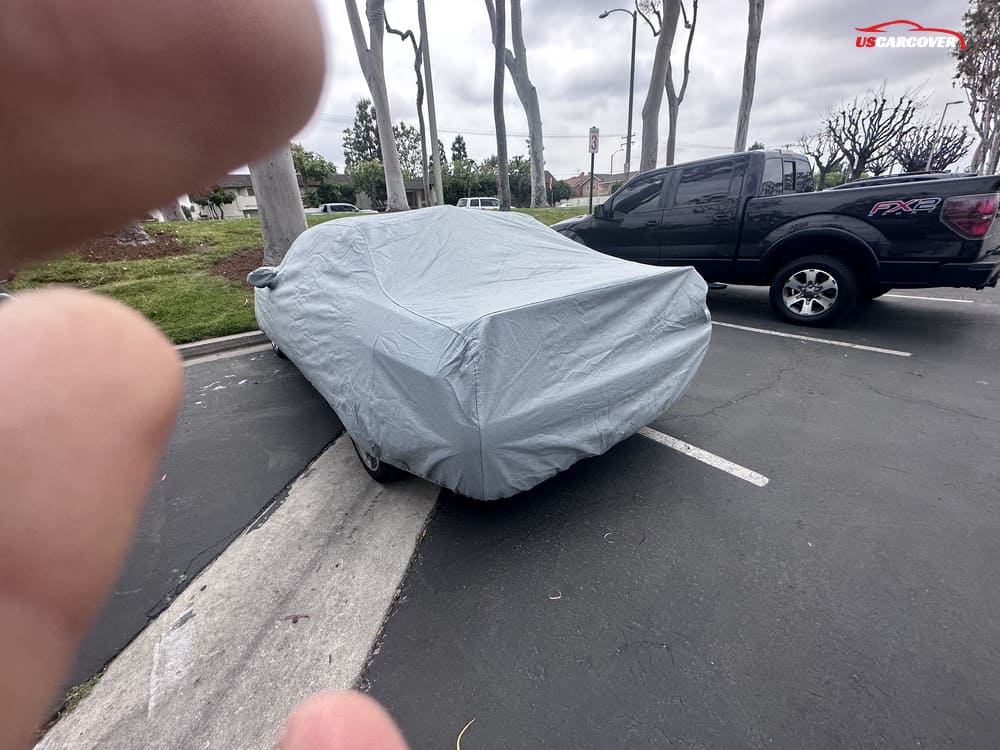
Additional Features to Measure
If your vehicle has unique features like a large spoiler, roof box, or extended mirrors, take extra care to measure those dimensions separately. These additions can affect how well the cover fits, and a failure to account for them may result in a poor car cover fit.
Using Manufacturer’s Sizing Charts
Once you’ve gathered your measurements, compare them with the manufacturer’s sizing guide. Reputable brands often provide detailed charts that help you match your vehicle’s dimensions to the right car cover size. This step is crucial in avoiding a misfit and ensuring that the cover you choose will provide full coverage and protection.
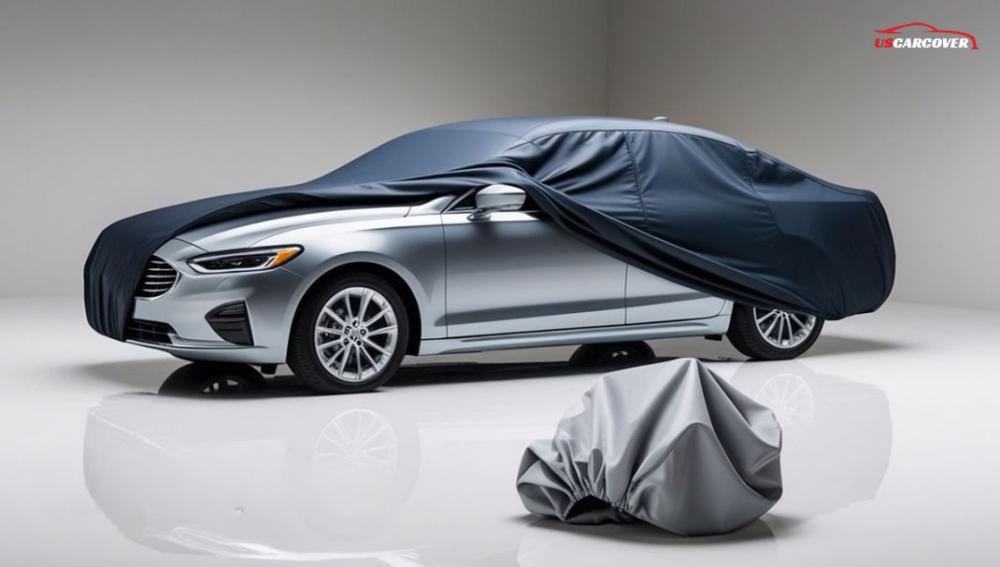
Why Accurate Measurement Matters
Taking the time to properly measure your car ensures that you’re not just guessing when purchasing a car cover. A well-fitted car cover is key to protecting your vehicle from dust, debris, rain, and sun, while also preventing the cover from flapping or moving during windy conditions. Accurate measurements prevent stretching, tearing, or bunching that can occur with improperly sized covers.
By following these steps, you’ll ensure you find the best-fitting car cover for your vehicle, allowing it to stay fully protected no matter where or how long it's parked.
Different Types of Car Covers and Sizing Guidelines
When choosing the right car cover, understanding the different types available and their specific sizing guidelines is essential. Whether you need a cover for indoor storage, outdoor protection, or specific weather conditions like snow or rain, each type of car cover has unique requirements for the perfect fit. Selecting the right cover type and ensuring the proper size will maximize the protection for your vehicle.
Indoor Car Covers
Indoor car covers are designed to protect your vehicle from dust, dirt, and accidental scratches while stored in a garage or other enclosed spaces. While these covers don’t need to be as rugged as outdoor covers, getting the right size is still crucial. A well-fitted indoor car cover will sit snugly over the vehicle, preventing dust from getting underneath. These covers are typically made from soft, breathable materials that won’t trap moisture, which is important for avoiding paint damage during long-term storage.
Indoor covers may not require the heavy-duty fit of outdoor covers, but you should still follow the manufacturer’s size guide to ensure a snug fit. A loose indoor cover can shift or wrinkle, which might cause minor scratches over time, especially if the vehicle is moved or bumped.
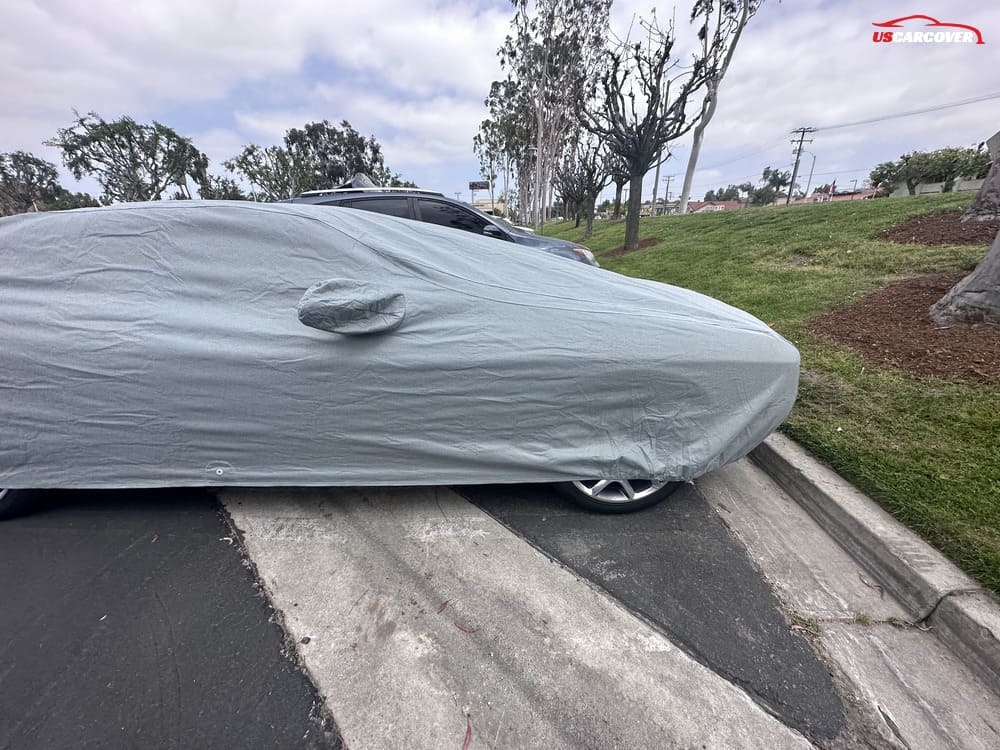
Outdoor Car Covers
Outdoor car covers need to be durable and resilient, as they face harsher conditions like rain, wind, UV rays, and temperature fluctuations. The right outdoor car cover size is critical to ensuring complete protection. A cover that’s too small will leave parts of your car exposed, while an oversized cover may flap in the wind, causing abrasion or even getting blown off entirely.
When choosing an outdoor cover, it’s important to account for any additional features your car may have, such as roof racks or antennas, as these will affect the fit. Look for all-weather car covers that come with reinforced seams and elastic hems for a secure fit. Some covers also have built-in straps or tie-downs, which are essential in windy conditions to keep the cover in place.
Snow and Hail Covers
For those living in colder climates, snow car covers or hail car covers provide an extra layer of protection against snow accumulation, ice, and hailstorms. These covers are often thicker and made from durable materials designed to withstand harsh winter conditions. Ensuring the correct size is vital to covering the entire vehicle and preventing snow or ice from seeping underneath.
When selecting a hail car cover, size becomes even more important as these covers are typically padded to absorb impacts. A snug fit ensures that the padding stays in place, providing full coverage without leaving vulnerable areas exposed.
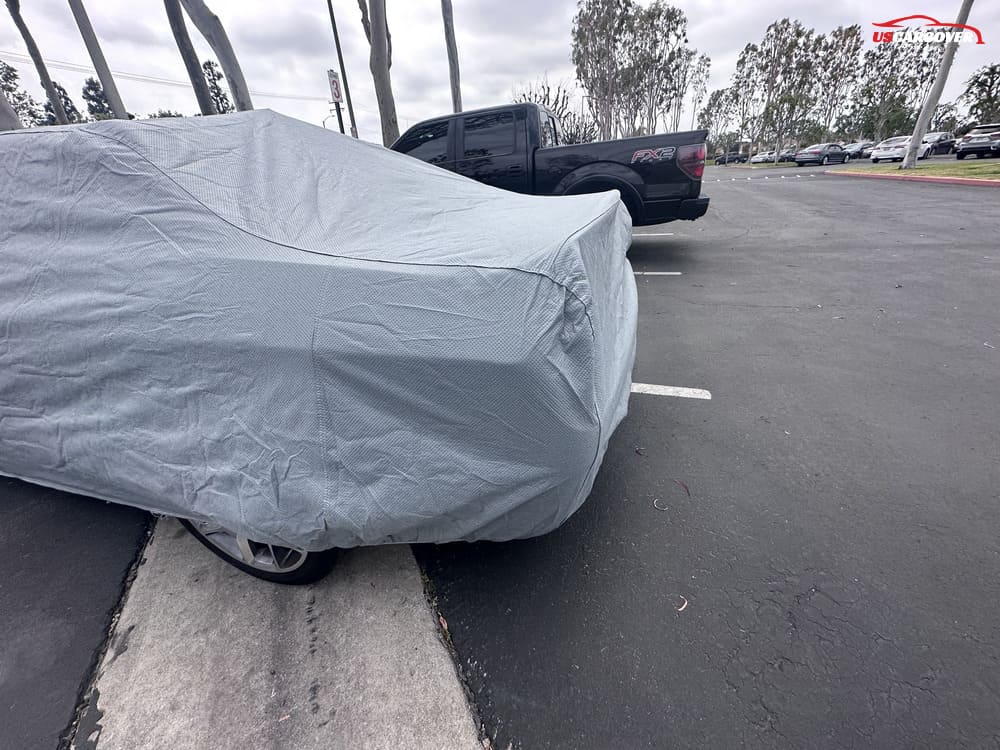
Related Articles: The Best Car Covers for Long-Term Storage | Protect Your Vehicle
Rain Covers
If your primary concern is rain protection, a rain car cover should offer a waterproof yet breathable solution. The size of the cover will determine how effectively it can prevent water from pooling on your car’s surface. A well-fitted rain cover ensures that water slides off the cover rather than collecting in pockets, which can lead to leaks or moisture buildup underneath the cover.
Custom vs. Universal Car Covers
While custom car covers are tailored to fit specific makes and models, universal car covers are designed to fit a broader range of vehicles. Custom covers generally offer a better, more secure fit, but they can be more expensive. Universal covers, on the other hand, are often more affordable and convenient, but you may need to be extra careful in choosing the correct size.
When considering which option to go for, always refer to the car cover sizing chart provided by the manufacturer to find the most accurate fit for your vehicle’s dimensions. Custom covers often have detailed sizing options that guarantee a perfect fit, whereas universal covers might come in general sizes like small, medium, or large, making precise measurement even more critical.
Custom vs. Universal Car Covers: Which One Fits Best?
When choosing a car cover, one of the most important decisions is whether to go with a custom car cover or a universal car cover. Both options have their advantages, but understanding which one provides the best fit for your vehicle depends on several factors, including your car’s unique specifications, where you park, and the level of protection you need. Let’s explore the pros and cons of each to help you decide which one is the best fit.
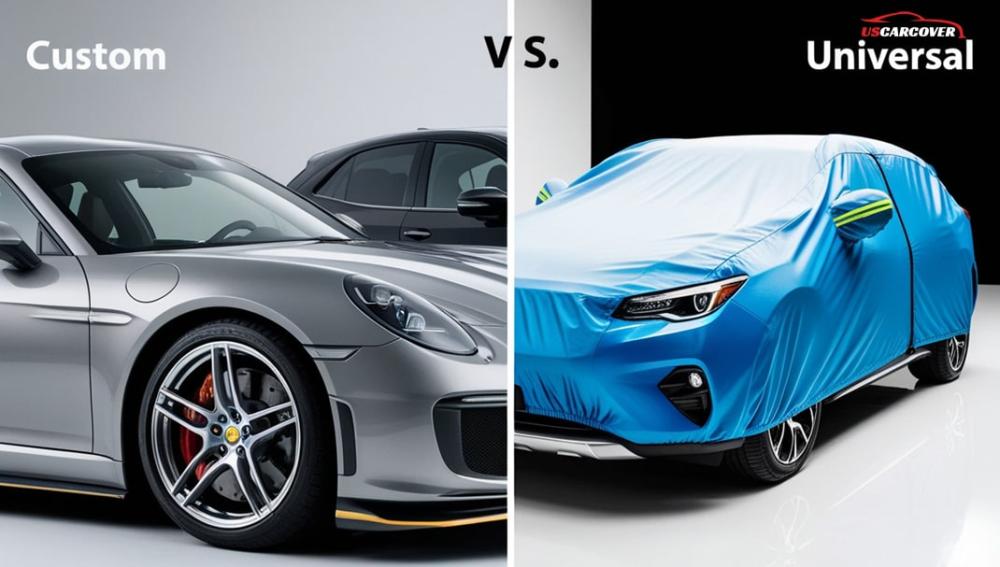
Custom Car Covers
Custom car covers are specifically designed to fit the exact make and model of your vehicle. These covers are tailored to hug every curve and contour of your car, offering a snug fit that provides full protection. Whether you have a compact sedan, a large SUV, or a classic sports car, custom covers are built to match the precise dimensions, including specific features like mirrors, antennas, and spoilers.
One of the biggest benefits of a custom-fit car cover is its superior coverage. The tight, secure fit ensures that no part of the vehicle is left exposed, making it ideal for long-term outdoor storage or protection in harsh weather conditions. Custom covers often come with features such as reinforced seams, elastic hems, and built-in straps that keep the cover in place even during high winds or storms.
However, the downside of custom covers is the cost. Because they are made specifically for your vehicle, they tend to be more expensive than universal options. Additionally, custom covers may take longer to manufacture and deliver, especially if they require special modifications.
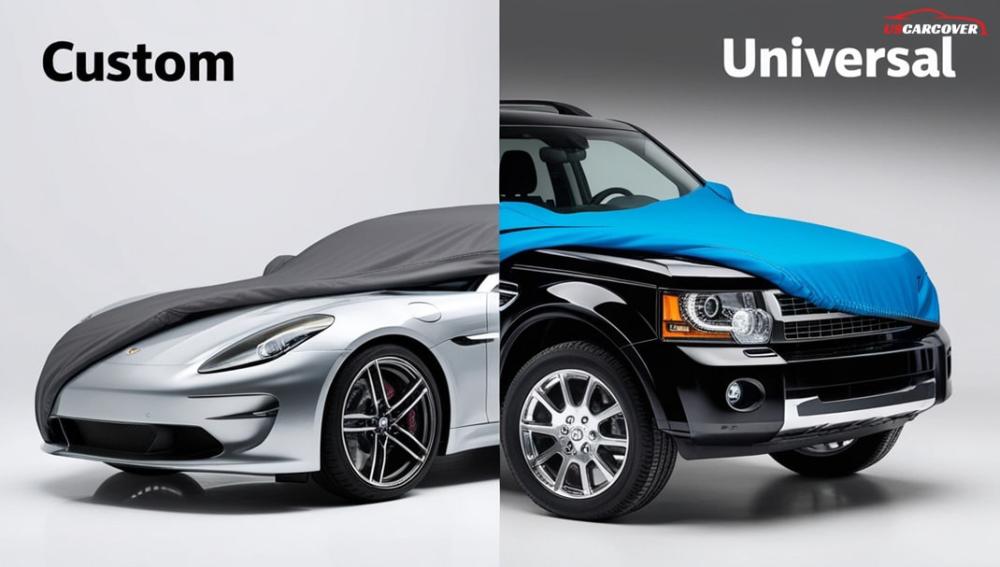
Universal Car Covers
Universal car covers are designed to fit a wide range of vehicles, offering a more affordable and readily available option. These covers come in general sizes like small, medium, large, and extra-large, which means they can fit multiple models within a certain size range. While they may not provide the exact tailored fit of a custom cover, they are often a convenient choice for those looking for immediate protection at a lower price point.
The main advantage of a universal car cover is its versatility. If you own multiple vehicles or need a cover quickly, a universal option can provide decent protection across different car types. Universal covers also tend to be easier to find and are often available for immediate purchase, making them a great solution for short-term or temporary use.
However, the fit of a universal cover may not be as secure or precise. Because these covers are designed to fit a variety of vehicles, they might not account for unique features like roof racks, large mirrors, or extended spoilers. This can lead to excess fabric bunching up or leaving parts of the vehicle exposed. In windy conditions, a loose-fitting universal cover could flap or blow off, reducing its effectiveness and potentially causing scratches to the paint.
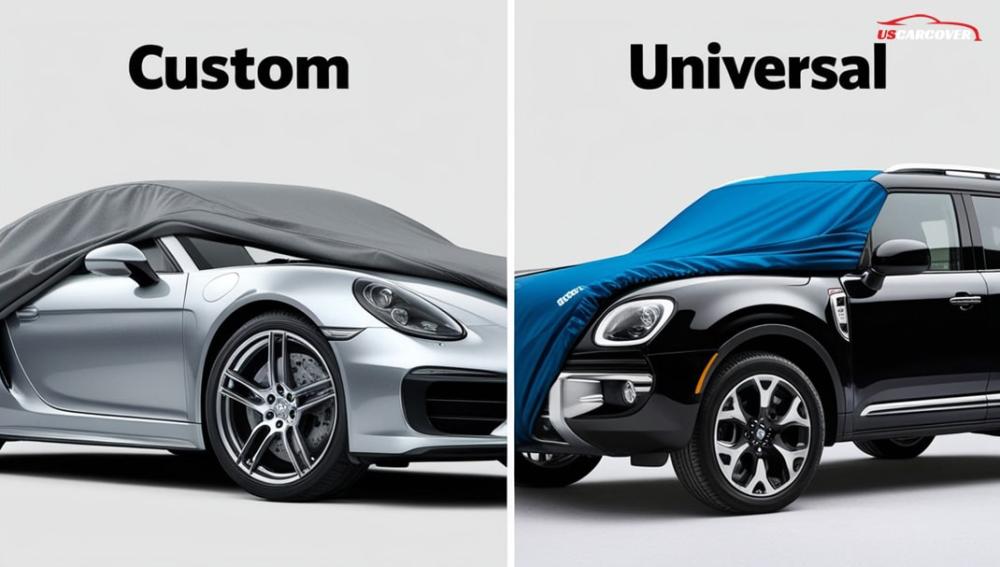
Which One is the Best Fit?
The choice between custom vs. universal car covers ultimately comes down to your specific needs. If your vehicle has unique features or you want the highest level of protection for long-term outdoor storage, a custom car cover is the best option. Its precise fit ensures that every inch of your car is protected, preventing damage from weather, dust, and debris.
On the other hand, if you’re looking for a budget-friendly option or need a cover that can work for multiple vehicles, a universal car cover might be the better choice. While the fit won’t be as tight as a custom cover, it can still provide solid protection, especially if you’re using it for short-term storage or in mild weather conditions.
Fitting Tips for Both Options
- Custom covers: Always double-check your vehicle’s make, model, and year to ensure the most accurate fit. Look for additional features such as mirror pockets or antenna sleeves that account for unique elements of your vehicle.
- Universal covers: Measure your vehicle’s length, width, and height carefully and compare them with the manufacturer’s sizing chart. If your vehicle has added features like a roof rack or large mirrors, you may want to size up to ensure full coverage.
Related Articles: Do Car Covers Really Protect Against Hail Damage?
Tips for Maintaining the Perfect Car Cover Fit
Even after finding the perfect car cover fit for your vehicle, maintaining that fit over time is just as important. Proper care and maintenance ensure your cover continues to provide optimal protection and doesn’t lose its shape, loosen, or become damaged. Below are essential tips to keep your car cover in top condition, ensuring it lasts longer and continues to fit snugly around your vehicle.
1. Clean the Car Cover Regularly
Dirt, dust, and debris can accumulate on the car cover over time, especially if it’s used outdoors. These particles can not only reduce the cover’s protective properties but also cause wear and tear, leading to loose spots or weakened seams. Regular cleaning helps maintain the integrity of the fabric and ensures the car cover fit remains tight.
For outdoor car covers, follow the manufacturer’s cleaning instructions carefully. Most car covers can be hand-washed or machine-washed on a gentle cycle with mild detergent. Avoid using harsh chemicals or bleach, as these can degrade the fabric and affect the fit over time. Indoor car covers can often be shaken out or spot-cleaned with a damp cloth.
2. Avoid Storing a Dirty or Wet Cover
Before storing your car cover, make sure it’s clean and completely dry. Storing a dirty or wet cover can cause mold, mildew, or bacteria to develop, which can weaken the material and affect the fit. If moisture gets trapped inside the fabric, it can lead to shrinking or stretching, impacting how well the cover fits over your car.
After washing, let the cover air-dry thoroughly before folding it. Never store your car cover while damp, especially if it's a custom-fit car cover designed to tightly hug your vehicle’s contours.
3. Proper Installation and Removal Techniques
How you install and remove the cover plays a big role in maintaining its fit. Avoid pulling or tugging on the fabric too hard, as this can stretch the material and distort the shape. When putting on the cover, start from one end (usually the front) and work your way to the back, ensuring the cover is aligned properly with the vehicle's edges and features.
When removing the cover, gently fold it from the back to the front, being careful not to drag it across the ground or rough surfaces that could damage the fabric. Regular use of improper installation or removal techniques can result in sagging or loose spots, reducing the perfect fit you once had.
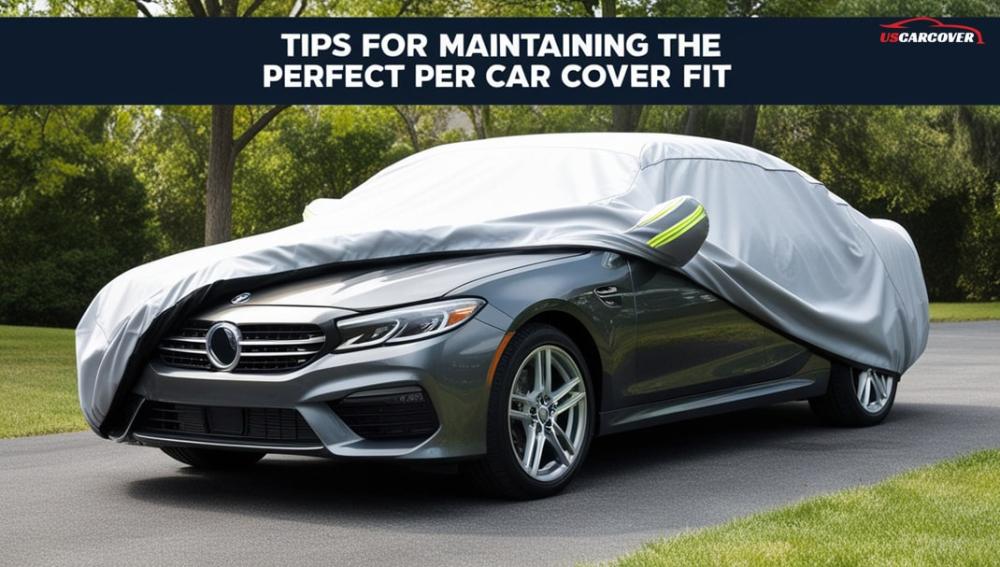
4. Store the Cover Properly
When your car cover is not in use, store it in a cool, dry place, away from direct sunlight or extreme temperatures. Prolonged exposure to UV rays or heat can weaken the material, causing it to stretch or fade, which affects the cover’s ability to fit snugly. Many covers come with storage bags that help protect the fabric when it's not in use.
Folding the cover properly before storage is also key to maintaining the car cover’s shape. Avoid crumpling or tightly compressing the fabric, as this can create permanent creases or folds that alter the fit.
5. Check for Signs of Wear
Regularly inspect your car cover for signs of wear, such as tears, holes, or weakened elastic hems. Over time, exposure to elements like wind, rain, and sunlight can cause the fabric to degrade. If you notice any damage, repair it immediately or consider replacing the cover if the fit is compromised.
Elastic hems, in particular, are critical for keeping the cover in place. Over time, they may lose their elasticity, resulting in a loose fit. Some car covers come with replaceable elastic bands, so you can restore the snug fit without having to purchase a new cover entirely.
6. Use Tie-Downs and Straps
For outdoor car covers, using built-in tie-downs or straps is essential for maintaining a tight, secure fit, especially in windy conditions. Straps help prevent the cover from flapping, which can stretch the fabric or cause it to shift. A well-secured car cover also reduces the risk of abrasions or scratches from loose material rubbing against your vehicle’s paint.
Always make sure the straps are properly fastened, but avoid over-tightening them, as this can cause stress on the fabric and eventually lead to tearing. Regularly check the straps for wear and replace them if they become frayed or lose their effectiveness.
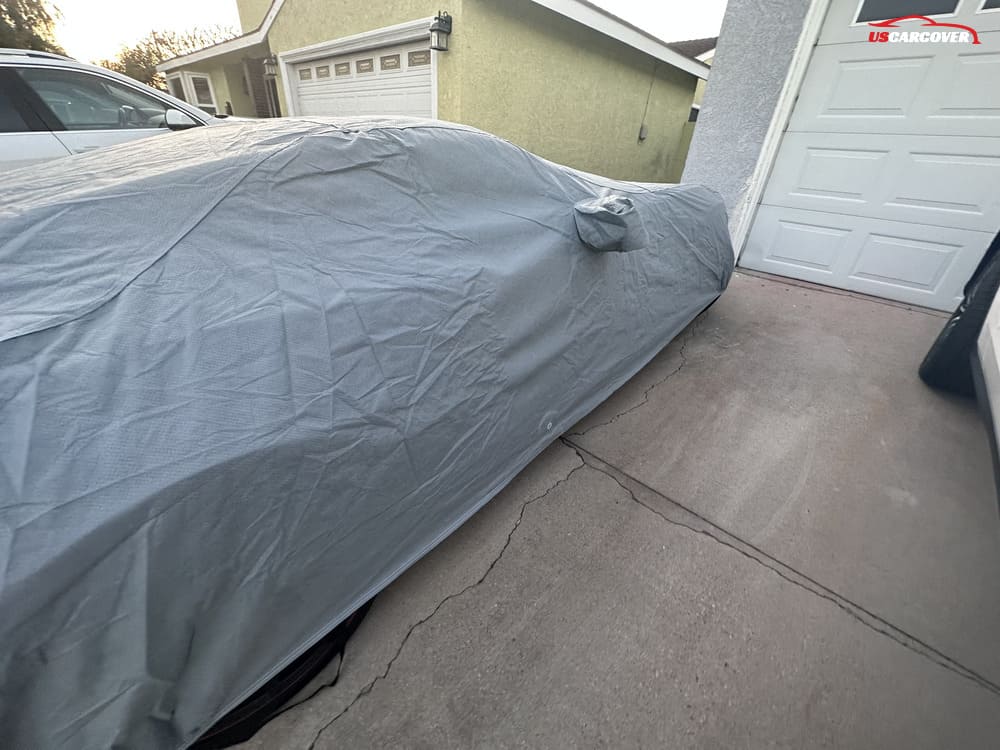
7. Rotate Your Cover
For vehicles in long-term storage, consider rotating the car cover occasionally to prevent any one section from becoming excessively worn or stretched. This helps distribute the wear more evenly and prolongs the overall life of the cover, ensuring it continues to provide a perfect fit over time.
Common Mistakes to Avoid When Choosing a Car Cover Size
Selecting the right car cover size is crucial for ensuring your vehicle receives full protection from the elements. However, there are several common mistakes that can lead to purchasing a poorly fitting cover, which can reduce its effectiveness and even cause damage to your car. Below, we’ll outline the most common errors and how to avoid them when choosing the perfect car cover.
1. Not Measuring Your Vehicle Properly
One of the most frequent mistakes is failing to take accurate measurements of your vehicle before purchasing a car cover. Many drivers assume they know the general size of their car—compact, mid-size, or large—but this can lead to ordering a cover that is too big or too small. Always take the time to measure your vehicle’s length, width, and height before selecting a cover. Remember to include additional features like spoilers, roof racks, or antennas in your measurements, as they can affect the fit.
To avoid this mistake, use a tape measure to get precise dimensions and compare them to the car cover sizing guide provided by the manufacturer. This step is key to ensuring you get the best-fitting car cover for your vehicle.
2. Choosing a Universal Size Without Checking Compatibility
While universal car covers are designed to fit a broad range of vehicles, they don’t always provide the perfect fit. One of the biggest mistakes people make is assuming that a “one-size-fits-all” cover will work for their specific vehicle. In reality, universal covers can leave excess material, creating loose spots that flap in the wind, or they may be too tight, leading to stretching or tearing.
To avoid this mistake, always check the manufacturer’s guidelines for universal covers. Many brands offer specific sizing charts for different categories of vehicles, such as small sedans, large SUVs, or trucks. By comparing your vehicle’s dimensions with the recommended sizes, you can find a universal car cover that fits more securely.
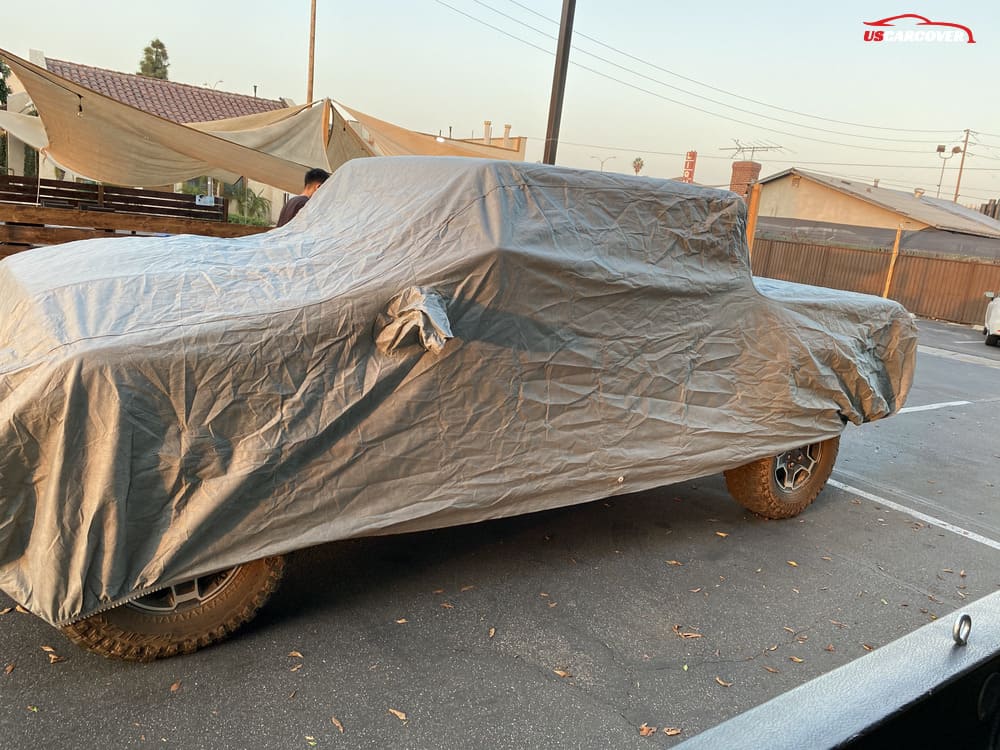
Related Articles: How to Choose the Right Car Cover for Your SUV
3. Ignoring the Impact of Vehicle Modifications
Another common error is overlooking modifications or aftermarket accessories that can affect the fit of the cover. Features like roof racks, large mirrors, spoilers, or extended antennas can significantly alter your vehicle’s shape and size. If these elements aren’t accounted for, you could end up with a cover that doesn’t fit properly or leaves parts of your vehicle exposed.
To avoid this mistake, look for covers with customizable features such as mirror pockets, antenna slits, or extra length for extended spoilers. You may need to opt for a custom-fit car cover to ensure your modified vehicle is fully protected.
4. Focusing Solely on Price
Many people focus too much on finding the cheapest option and end up with a car cover that doesn’t offer a good fit or long-lasting protection. While budget is important, selecting a cover based purely on price often leads to purchasing a poorly fitted cover that can shift, flap, or tear easily. A cover that doesn’t fit snugly won’t protect your vehicle properly, which can lead to further damage over time.
To avoid this mistake, consider the quality of materials and the fit just as much as the price. Investing in a durable, weather-resistant car cover that fits your vehicle well will save you more money in the long run by protecting your car from damage.
5. Not Considering Weather Conditions
Failing to account for local weather conditions can lead to choosing a car cover that doesn’t fit well under certain environmental circumstances. For example, a lightweight indoor cover may not stay securely on your vehicle during strong winds, while a rain cover designed for wet climates might not offer enough breathability in hot, dry conditions. Covers that don’t fit tightly enough in windy areas can flap against your car’s paint, causing scratches or wear.
To avoid this mistake, select a cover that’s designed for your climate. Outdoor car covers with reinforced seams, tie-downs, and elastic hems can help ensure a better fit, especially in areas prone to extreme weather conditions. Additionally, consider investing in covers specifically designed for snow, hail, or rain if you live in an area with frequent inclement weather.
6. Overlooking the Manufacturer’s Sizing Chart
Each car cover brand typically provides a car cover sizing chart, which includes detailed dimensions and recommended vehicle types. One of the most easily avoidable mistakes is failing to consult this chart before making a purchase. Some drivers assume their vehicle will fit a certain size without checking, leading to a cover that doesn’t fit properly.
To avoid this mistake, always review the sizing guide provided by the manufacturer, whether you’re buying a universal cover or a custom car cover. Double-check your vehicle’s measurements against the chart to find the size that offers the most accurate fit.
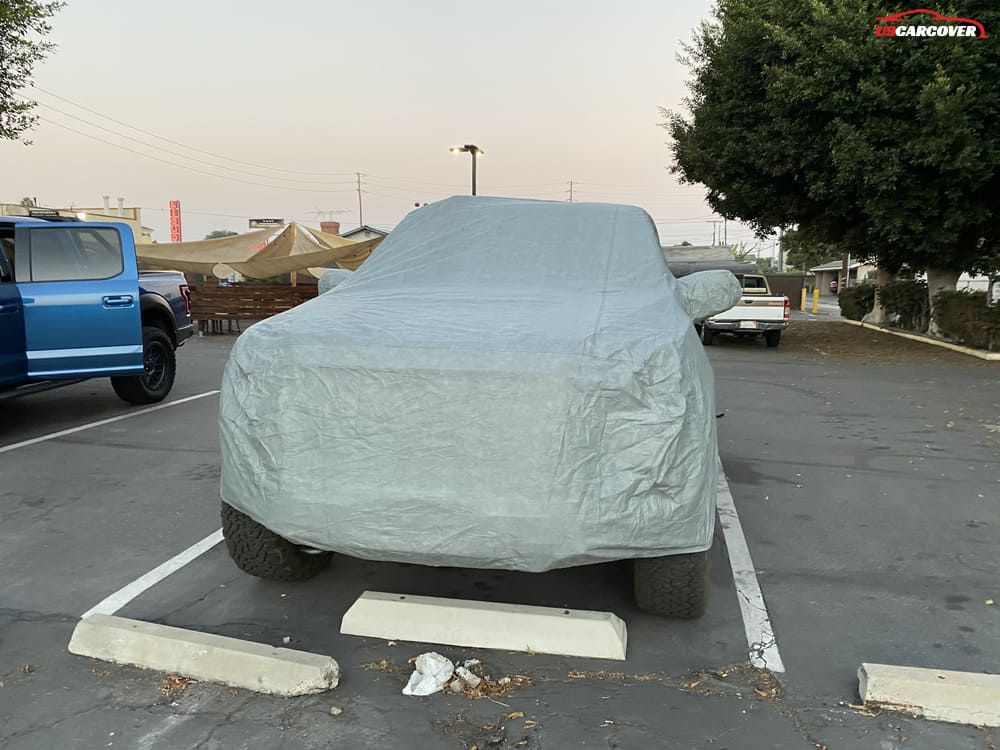
7. Ignoring the Importance of Fit for Long-Term Storage
If you’re planning to store your vehicle for an extended period, the fit of your car cover becomes even more critical. A loose or poorly fitted cover can allow dust, debris, and moisture to get underneath, potentially causing damage to the paint, trim, or other parts of your car. A tight, secure fit prevents these issues, ensuring your vehicle remains in pristine condition during storage.
To avoid this mistake, choose a custom-fit car cover if you’re storing your vehicle long-term, as it will offer the best protection and maintain its fit over time. Ensure that the cover provides a snug, secure fit, with elastic hems and reinforced seams to prevent shifting or loosening during storage.
Related Articles: Custom-Fit vs. Universal Car Covers – What’s the Difference?
Protect Your Investment with the Perfect Fit – Shop Now at USCarCover.com
When it comes to keeping your vehicle safe from the elements, scratches, and long-term wear, the right car cover makes all the difference. Don’t settle for one-size-fits-all solutions that leave your car vulnerable—choose a custom-fit car cover designed specifically for your vehicle’s make and model. At USCarCover.com, we offer a wide selection of high-quality, durable car covers that provide maximum protection and a snug fit.
Whether you need a cover for indoor storage, outdoor protection, or harsh weather conditions, USCarCover.com has you covered. Our custom-fit covers are designed to fit all types of vehicles, ensuring full protection from rain, snow, UV rays, dust, and debris. Plus, they’re currently on sale for under $100!
Why Choose USCarCover.com?
- Premium Quality Materials: Weather-resistant and durable for long-lasting use.
- Perfect Fit for Every Vehicle: Tailored to your car’s exact specifications.
- Affordable Prices: Get premium protection at an unbeatable price.
- Fast and Free Shipping: Delivered straight to your door.
Don’t wait until damage is done—protect your vehicle today with a custom-fit car cover from USCarCover.com. Visit our website now to browse our selection and find the perfect cover for your car. Shop now and ensure your vehicle stays in pristine condition for years to come!
